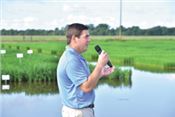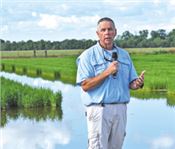|
Weather Changes Affecting Rice Crop
KLONDIKE, LA.
Weeks of dry weather transitioned to widespread rainfall, and now rice farmers will have to be wary of the potential for disease in their crop, an LSU AgCenter plant pathologist advised at the Vermilion Parish rice field day on June 5.
“This has changed everything,” said Don Groth. “All diseases need moisture to develop.”
Rain caused the Vermilion Parish rice field day to be moved indoors instead of its usual location at the Kent Lounsberry Farm. The southwest field day was held May 30 at the Johnny Hensgens Farm near Iowa, and the Evangeline Parish field day was held the following day at the Cody Bieber Farm near Mamou.
Cold winter weather killed volunteer rice that would have harbored many pathogens, and that has helped this year’s crop, Groth said.
No one has complained so far about Cercospora on their rice. “Last year at this time we were already treating fields for Cercospora,” he said.
A fungicide application for Cercospora should be made between the boot stage and heading.
Later-planted rice should receive fungicides earlier than usual, Groth said.
He said he has received reports of blast. In one case, a farmer had problems maintaining a flood in a field surrounded by trees, and the crop had been fertilized excessively, all conditions favorable for that disease.
A new fungicide, Amistar Top, has excellent activity against sheath blight, but it should be rotated with other fungicides to prevent diseases from developing resistance to it, Groth said.
No other new fungicides are on the horizon. “What we have is what we’ll have for a number of years,” he said.
AgCenter economist Mike Deliberto said this year’s U.S. rice planting increased to 2.7 million acres, 227,000 acres more than last year. Arkansas acreage is at 1.3 million, compared to 1.2 million last year.
Louisiana acreage increased by 10,000 acres to 410,000, he said.
The nationwide acreage increase is expected to keep long-grain prices around $11.50 per hundredweight.
“With the rice price at $11.50 per hundredweight, the larger supplies that come online this year will make U.S. rice more competitive in the export market as the price differential over Asian competitors narrows,” he said.
The carryover from last year’s crop is the lowest in four years, and sales have increased to countries in Central America and the Mediterranean.
It’s uncertain if the U.S. will be able to sell rice to China. “I think progress is being made,” Deliberto said.
AgCenter rice breeder Adam Famoso said new lines of Provisia rice are under development. The first Provisia variety, PVL01, has a lower yield potential than other varieties, but that was true with the first versions of Clearfield, he said.
Higher yields from Provisia will be developed. “It’s just going to take some time,” he said.
The line PVL108 is a possible successor to PVL01 with improved yields. Enough of the line was grown in Puerto Rice last winter to plant a 5-acre foundation seed increase this year at the LSU AgCenter H. Rouse Caffey Rice Research Station.
An emphasis is being placed on new conventional long-grain varieties, and Famoso said two lines showing promise could be released in two years.
A Clearfield long-grain variety with high yield potential will be considered for release, but its quality traits will be closely examined, he said.
The new Clearfield Jasmine-type variety, CLJ01, released late last year, has 30 percent more yield potential than Jazzman-2, with low chalk and good milling quality, Famoso said.
AgCenter entomologist Blake Wilson warned farmers about insect control. “This is going to be a bad rice water weevil year,” he said.
High infestation levels could decrease yields by 20 to 30 percent if not controlled. Farmers who did not use a seed treatment should scout often for the pest. “It’s not too late to consider spraying,” Wilson said.
Cold winter weather has suppressed stem borers, but they could become a problem by mid-July.
Stink bugs can become a problem after rice is headed, he said. The threshold for spraying is three insects per 10 sweeps for the first two weeks of heading, and later in the growing season, 10 insects per 10 sweeps.
Invasive apple snails were discovered in rice and crawfish ponds for the first time this spring. What impact the snails will have on rice production is not known, but they have not been highly damaging to rice in Texas. They may have worse effects on crawfish farms where high numbers of snails were observed clogging traps, Wilson said.
“We do know the snails are present throughout the Mermentau River Basin,” he said.
AgCenter agent Andrew Granger said the snails have also been found in the Vermilion River Basin.
AgCenter rice specialist Dustin Harrell said using gibberellic acid should be considered on fields where a second crop will be grown. The chemical has been shown to boost second-crop yields when applied at the soft dough stage at the rate of 4 grams per acre.
This year’s crop looks good, but nighttime temperatures will be critical as the plants transition into the pollination phase. Overnight low temperatures above 75 degrees are stressful for pollinating plants, he said.
AgCenter weed specialist Eric Webster said herbicide drift complaints on soybeans are being made mostly in Arkansas and Mississippi with the new herbicide Loyant. The material is a hormone that is active in tiny amounts. Most herbicides are not active after traveling long distances, but Loyant remains active, he said.
Webster will be testing Loyant at low concentrations on soybeans to study the effects.
Loyant is a fast-acting herbicide, with some weeds affected in just a few minutes, and soybeans show damaging effects in a few hours.
Webster cautioned farmers against tank mixing other herbicides with Provisia, especially propanil. Provisia mixed with another chemical should be sprayed as soon as possible to reduce the chances for antagonism. He also said no tank mixing should be done if an application is intended for grasses in the tillering stages.
Young rice plants sprayed with the Provisia herbicide will show signs of injury, but slight injury is not a concern. “It tells me that herbicide is working like it’s supposed to,” he said.
AgCenter soybean specialist Todd Spivey said projections are that Louisiana farmers will plant 1.3 million acres of soybeans, a slight increase from last year. A higher seeding rate should be used for late-planted soybeans, but no more than 150,000 plants per acre.
Growers should expect that stink bugs will move to late-planted soybeans after the earlier-planted beans are harvested, Spivey said. ∆

LSU AgCenter entomologist Blake Wilson speaks at the southwest Louisiana rice field day
near Iowa on the Johnny Hensgens farm on May 30.

LSU AgCenter weed scientist Eric Webster speaks at the Evangeline Parish rice field day on May 31.

LSU AgCenter rice breeder Adam Famoso talks at the Evangeline Parish rice field day held
at the Bieber farm near Mamou on May 31.

LSU AgCenter plant pathologist Don Groth speaks to farmers at the Vermilion Parish rice field day on June 5.
Photos by Bruce Schultz/LSU AgCenter
|
|